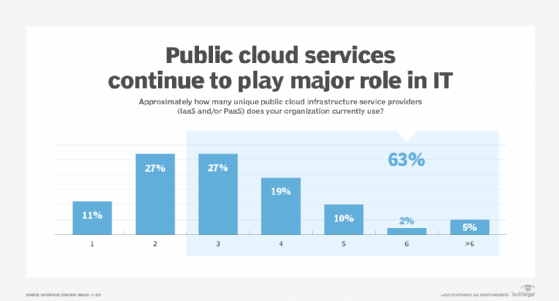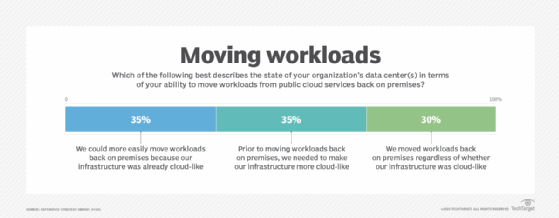
Getty Images/iStockphoto
On-premises data centers play key role in distributed clouds
Enterprise Strategy Group's Scott Sinclair shares survey results on the benefits and challenges of managing distributed clouds. Data centers remain an essential part of the mix.
As organizations strive to transform into digital businesses and sell more digital products and services, they tend to become more data-centric, speed up their operations with AI-based automation and use several public cloud service providers, according to a recent survey by TechTarget's Enterprise Strategy Group.
But a multi-cloud approach -- an essential component of transformation -- is fraught with complexity. Organizations named network interconnection, integrating with legacy environments and meeting performance expectations among the significant challenges.
The survey, part of Enterprise Strategy Group (ESG)'s Distributed Cloud Series, drew responses from 377 IT professionals in North America. It was designed to assess the state of application infrastructure environments and the movement of data and applications across distributed clouds. ESG also wanted to learn about the on-premises and cloud infrastructure of survey respondents and how application strategies affect infrastructure decisions.
The survey showed 63% of respondents using two or more cloud service providers and detected a moderate shift away from on-premises data centers to public cloud infrastructure (Figure 1). On the other hand, while survey respondents expressed a desire to reduce data center expenses, only 15% expected to be operating fewer data centers five years from now. And many are "repatriating" workloads from the cloud back to data centers that are becoming more cloudlike (Figure 2).
In this Q&A, Scott Sinclair, an ESG analyst, discussed the findings and offered theories about the continuing role of on-premises data centers in a supposedly cloud-first age that relies on distributed clouds.
Editor's note: The following was edited for length and clarity.
What were the major findings?
Scott Sinclair: The high-level takeaway is cloud adoption continues to grow, driven by transformational business benefits and technical benefits and the need to move faster, improve time to value and get better access to innovation. Organizations also want better security, scalability and flexibility.
 Scott Sinclair
Scott Sinclair
There is still a significant list of challenges around connection and getting all these sites to work together, whether it's getting all the teams to collaborate or connecting all the different cloud providers into your CI/CD pipeline and managing all the APIs.
When you're migrating applications, dealing with the differences between locations starts to arise. You have to meet security and cost expectations and learn the different architectures.
Success is really defined by the ability to take multiple independent clouds and build something that's able to operate together as a true multi-cloud environment rather than having disparate, siloed clouds, each with its own team, management interface and way of doing things. It diminishes the reasons why you adopted cloud in the first place, such as agility.
One way to look at it is to ask how to approach multi-cloud from an organizational standpoint to get people to collaborate better. The second way is from a tools and training standpoint. Organizations need to approach multi-cloud with the assumption that everything has to be connected. So, they need to think about tools and processes and technologies that simplify the movement and the management of apps and data across lots of different locations.
To do that, you need commonality: something that helps you provide the same experience across different locations.

Why do companies use so many clouds?
Sinclair: They want access to all the great business benefits: improved time-to-value, better access to innovation, risk management, reuse and total cost of ownership. They also want technology benefits like better security, scalability, flexibility and agility.
What struck you about how people view their data centers?
Sinclair: We've been hearing for decades that the data center's dead and cloud is the future. We asked people how many data centers they plan to have in the future, and they said they're going to have a lot more. Every time I share that with people, they're surprised and say they don't agree. We've done two different studies, and this is what happens.
The point is the demise of the data center is greatly exaggerated. It is not going away. Given the demands of technology and data, we need technology everywhere, and we need good technology everywhere.
Out of this group of 377 people, only 56 of them -- 15% -- said they planned to operate fewer data centers in the future. That is really telling.
When we ask why, the people who say they're getting rid of the data center are just going out of business. Their business model is under pressure, and they have to reduce their operating and real estate costs and downsize people. They're going to have fewer applications to support.
Other reasons for retiring data centers were more around efficiency: companies that want to reduce to try to get better control, including from a disaster recovery standpoint.
Part of that is done with modern -- and on-premises -- infrastructure that requires fewer data centers.
Of all the reasons people gave for why they're getting rid of their data center, only 36% said it was because the cloud is winning the war. Everyone else is either going out of business or believe the technology and data center have gotten so good that they don't need as many.
These results reinforce that any narrative that says on premises versus off premises is a zero-sum game -- where if cloud wins, data center loses -- is just ridiculous.
The survey showed some other interesting views on data centers. Can you summarize what you found surprising or interesting?
Sinclair: Organizations expect that in five years they're going to have significantly more data centers, which I think is really interesting.
What that says to me is organizations are looking at their IT demands over the next five years and what the cloud will be able to provide. And then they ask what's left over and what they don't think they can do in the cloud in five years. They look at their own data center capabilities and say, 'I'm going to need more. My cloud providers can't do everything I need. If I keep growing this way, I'm going need to build more data centers now.'
Fast forward five years, and those needs may actually be filled by the cloud: secondary cloud providers that show up, colocation providers, edge locations or some other new technology.
Digital demands are so massive, growing so quickly and so important that organizations have overwhelmingly come to the conclusion that they can't rely on the cloud alone for the foreseeable future. They're going to have to modernize what they're doing on premises and look for alternatives.

What do the survey results say about trends in hybrid cloud environments?
Sinclair: They highlight just how complex this whole thing is.
Five to 10 years ago, the prevailing theory was, 'Data center is dead, the future is all cloud, move everything to the cloud.' You saw a lot of CIOs hired with a mandate from the executive team to be cloud-first.
Cloud-first organizations still exist, and that approach still works. What we're seeing now, though, is as maturity has grown, organizations are coming to understand that there is no one-size-fits-all answer for everything they need to do and that their best option is to leverage as many options as they can, as quickly as they can.
What does the title of one of your survey presentations, 'The API-driven Infrastructure Imperative,' refer to?
Sinclair: People don't want to manage things via UI anymore. People want to automate, and they use APIs to automate their infrastructure through tools like Terraform.
It is still so early that people are struggling just to do the bare minimum. It is complex and difficult. When we asked what processes they automate with infrastructure tools, they said they're just trying to automate security scans, monitoring and reporting. They're nowhere near trying to automate a lot of the actual actions.
Organizations absolutely look at how APIs fit in their environment and the APIs' capabilities before they purchase new infrastructure because it's so important.
The survey confirmed the importance of team coordination. Can you elaborate?
Sinclair: Getting the teams to work together is really tricky -- whether you're getting the cloud team to work with the traditional IT teams or getting all the different cloud teams to work together when migrating apps from one cloud to another. Only 10% of respondents chose both answers. That probably means organizations tend to be in one camp or the other: Either they have a cloud team and a traditional IT team or they have lots of different cloud teams. When you combine the two, 63% said they face this challenge.
In light of what you say about the challenges of multi-cloud and hybrid cloud, what's your advice on how to how to deal with it?
Sinclair: Expect movement, expect change. Expect things to become more distributed. Design your organization to better enable collaboration across locations.
Your data center team and your AWS, Google and Microsoft Azure team have to work together. Just assume that's going to happen.
And in a similar fashion, assume that apps and data are going to have to move everywhere all the time.
Invest in tools and capabilities that make that as simple and seamless and easy as humanly possible while minimizing getting locked into a particular solution.
It's very easy for me to say and far more difficult to execute. I see organizations that go all in on one cloud provider, for example, and use all the native cloud tools. There are tons of benefits in doing that, but as soon as they start branching out into multiple clouds, they find that all the learning doesn't translate. It's simple things like someone focused on AWS tools not being able to fill in for an Azure person. If they were using a common toolset, they could.
Little things like that just kill you over time. A better mindset is to realize you need a tool that can give you visibility across locations.
Read the full survey results
Enterprise Strategy Group subscribers can click here for a report on the survey covered in this Q&A.






